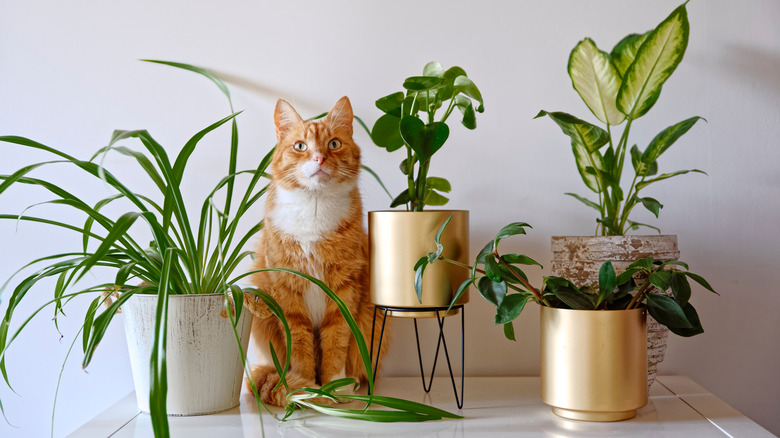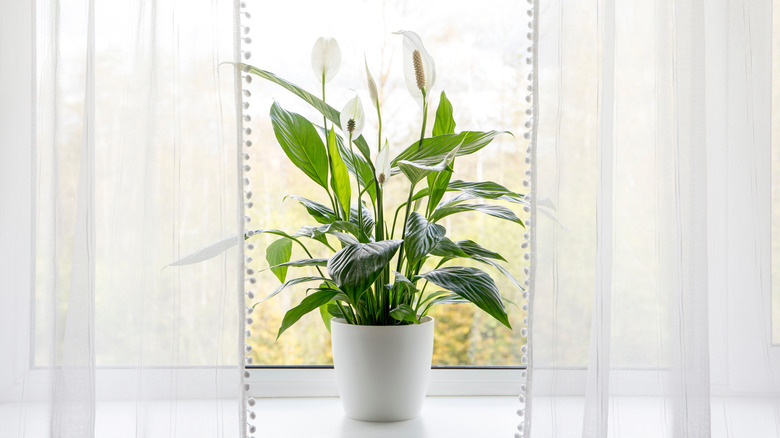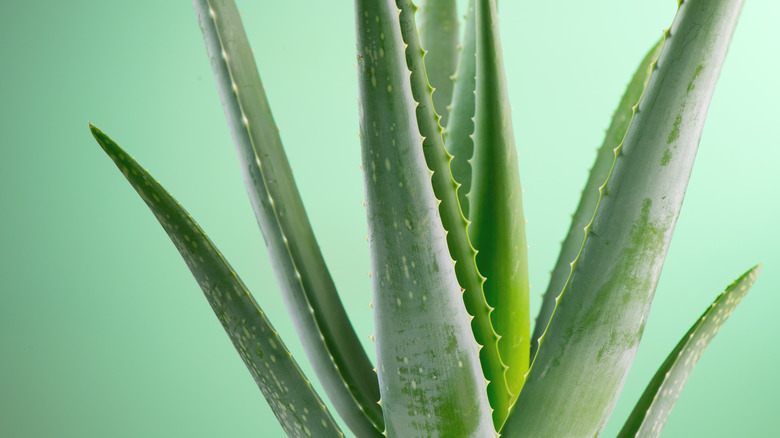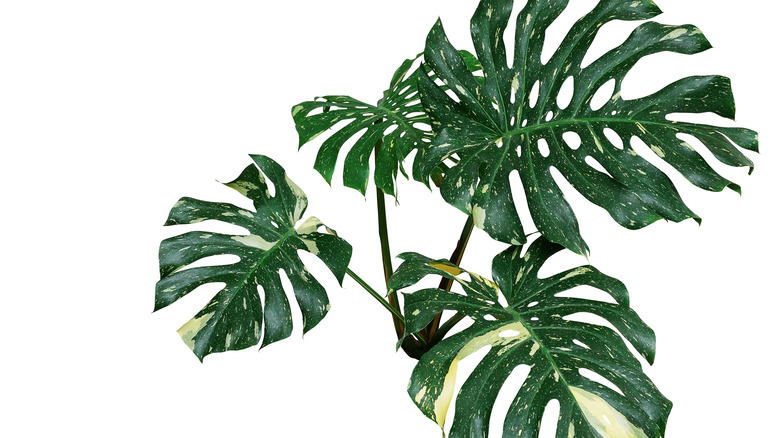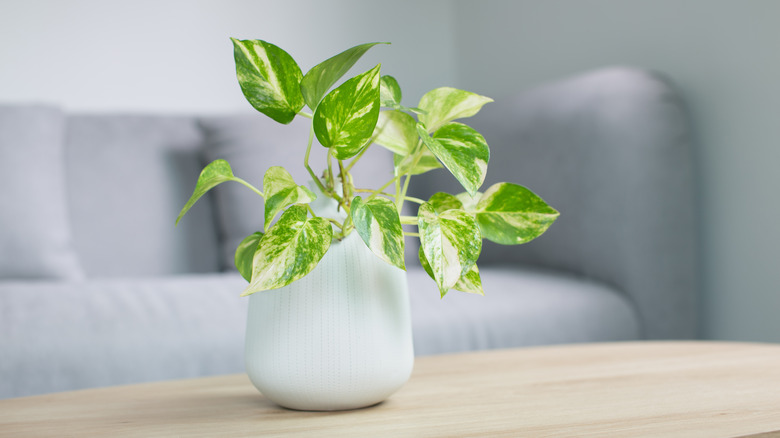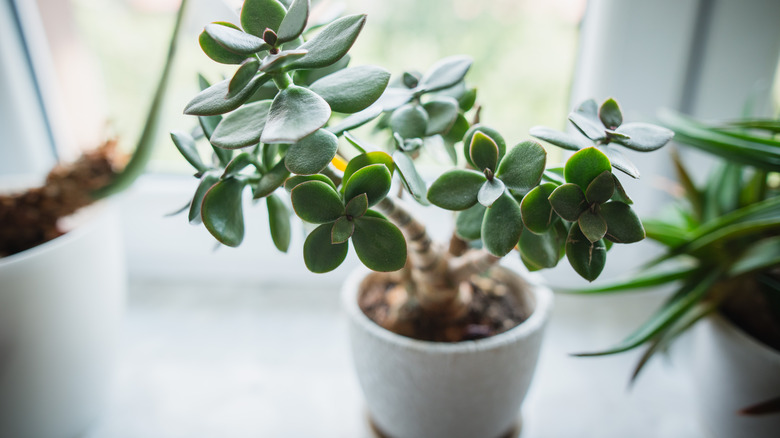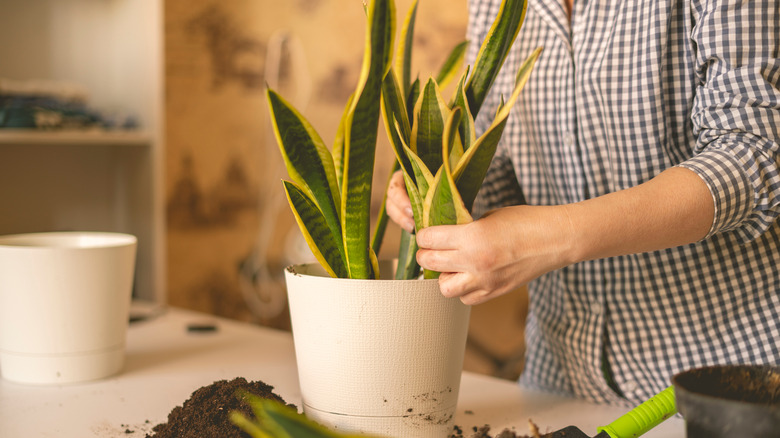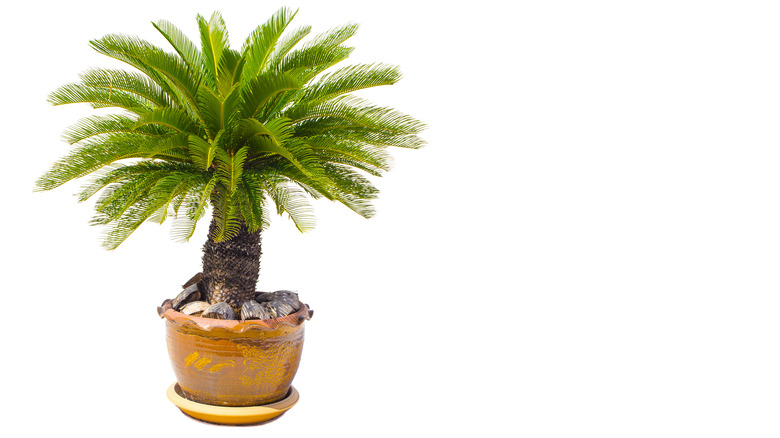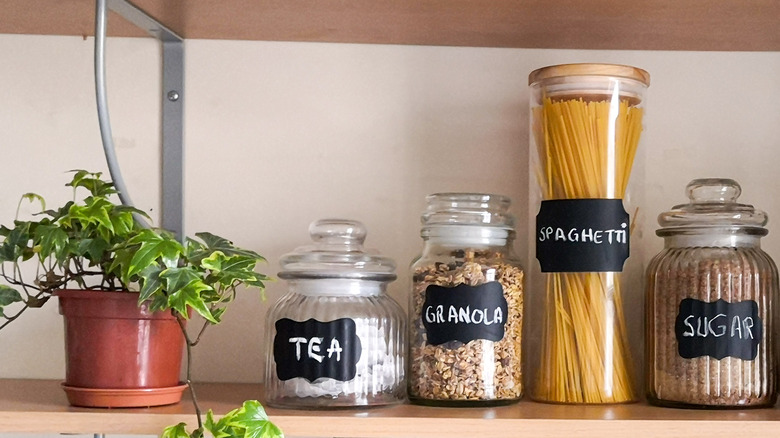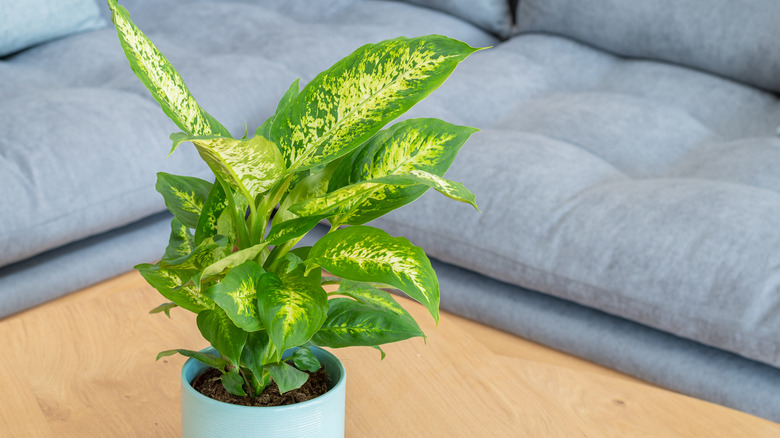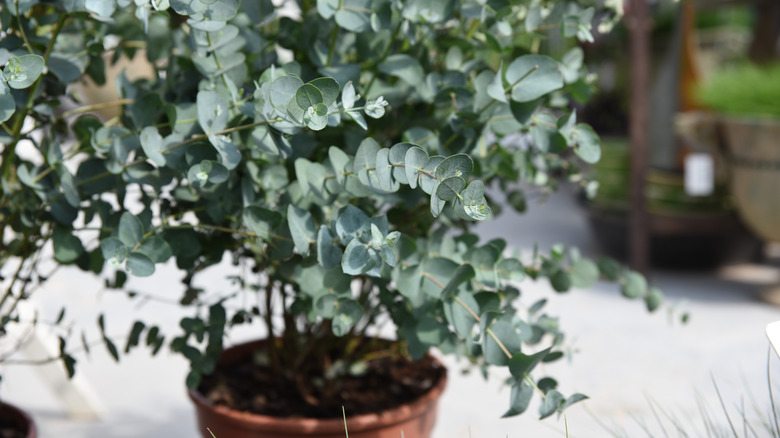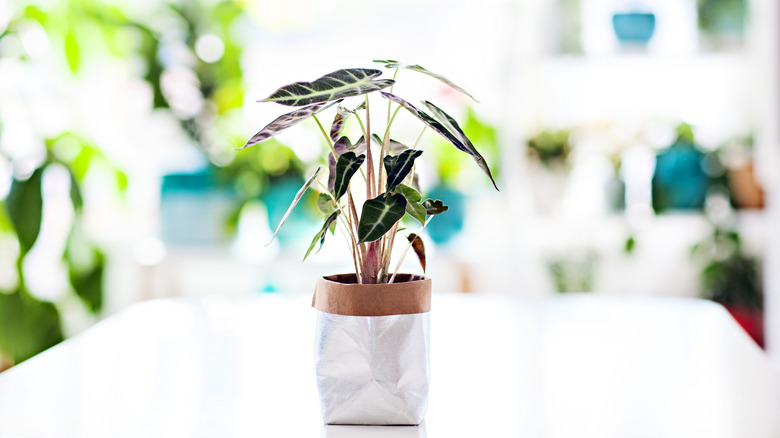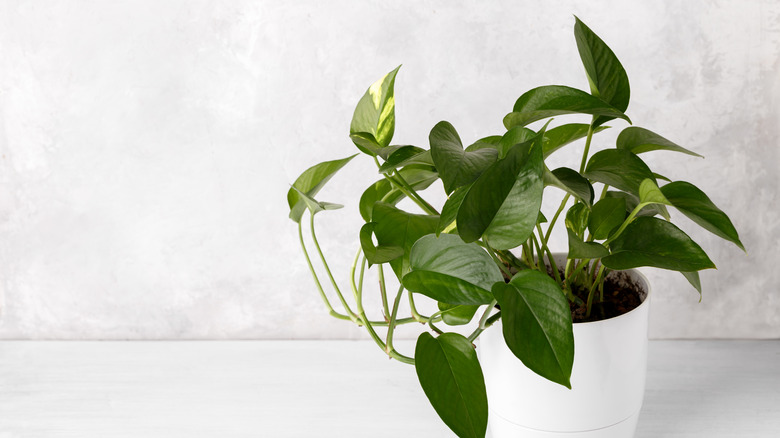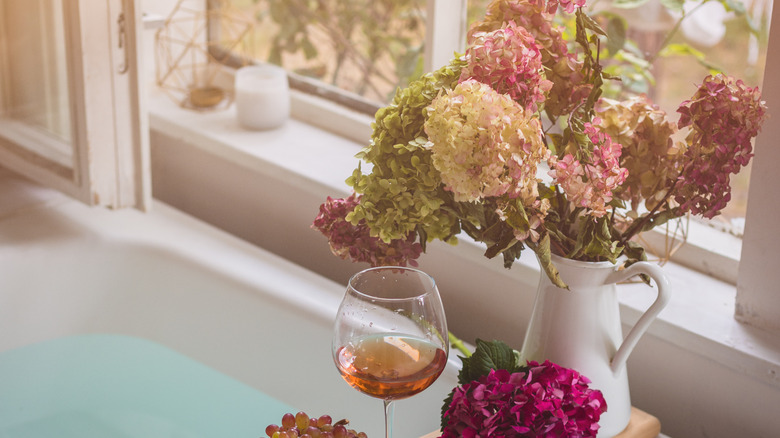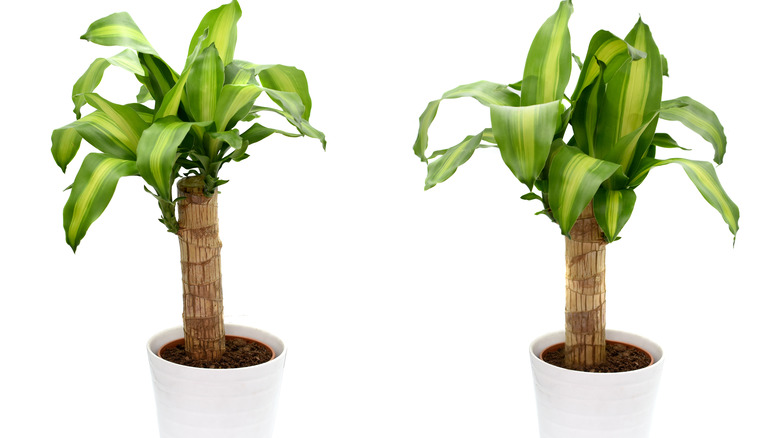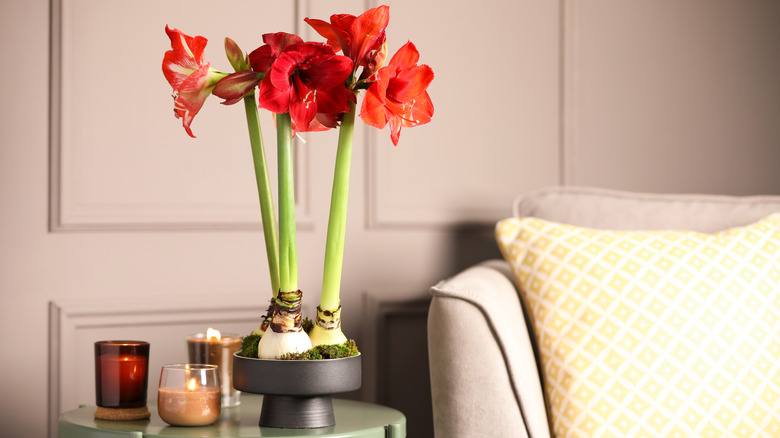15 Houseplants That Are Actually Poisonous To Cats
Besides bringing natural beauty into your home, houseplants provide health benefits; they keep the air clean by absorbing carbon dioxide and other contaminates. In a mere 24 hours, such indoor greenery rids the air of 87% of its toxins, according to NBC News, which quotes a NASA study. But that's just the beginning — houseplants also improve concentration and productivity by 15% and can make you happier and less stressed.
Sounds good, right? So, why not just fill your home with flora? Pet owners, especially those with felines, must be careful when selecting houseplants. Unfortunately, cats like to nibble leaves. Those fronds flickering in the breeze are too much of a temptation for playful kitties, who eat to obtain extra nutrients and because they are sometimes bored during the day, according to Cat Health. Some of the consequences of chomping on toxic leaves your pet might experience are: breathing difficulties, vomiting, excessive drooling, diarrhea, irregular heartbeat and other things — all ailments your furry family member wants to avoid (per Pet MD). To that end, keep your pet safe by becoming mindful about your houseplant choices. Here are 15 houseplants that are actually poisonous to cats.
1. Peace lilies
Peace lilies (spathiphyllum) look lovely, especially when they blossom. These delightful, white flowered, dark-leaved plants are especially popular at Easter. Oh, and they're so low maintenance, too. A little watering when it droops and you're done. Too bad, peace lilies have calcium oxalates — something that irritates the GI tract and mouth and induces vomiting when cats eat the plant. At worst, the toxins impede swallowing and breathing, per The Spruce. The lily, which is more of a relative of the elephant ear than a proper lily, is easy to grow since it likes shade, partial shade or even fluorescent lights — so it's perfect for the office, where your feline isn't! (via HGTV).
2. Aloe vera
Aloe vera (Aloe barbadensis miller), the same plant that can cure your sunburn can cause vomiting, depression, diarrhea, anorexia, and tremors in felines; you might also see your cat's urine change color, said Pet Helpful. That's because it contains anthraquinone glycosides, a type of laxative, according to Homes to Love. To keep this plant happy, you need to provide indirect sunlight and a container that is porous so the soil stays dry and well-drained, according to The Old Farmer's Almanac. While you can apply the aloe gel topically for first aid use, never ingest it — what's toxic for your pet also can give you stomach ailments.
3. Split-leaf philodendron
Split-leaf philodendron (monstera deliciosa) or the Swiss cheese plant is a bit of a mystery. The ASPCA puts it on its toxic list because it contains calcium oxalate crystals, which can trouble your mouth if eaten (think some pain or irritation), and in extreme cases cause swelling, according to House Plant Central. So it's one of those plant types you can keep around, but pay attention to how your cat interacts with it. The plant likes heat — 75 degrees Fahrenheit during the day — and indirect sunlight. Soil should never become too dry or wet, and you can use a spray bottle to mist it once a week to up humidity levels, said SF Gate.
4. Pothos
Pothos (Epipremnum aureum) hangs gracefully from hanging planters and pots. A breeze to take care of, the plant becomes painful if your cat chooses to try it. Your pet will ingest insoluble calcium oxalates and will feel burning in its mouth as well as possible swelling. It can also cause vomiting, so keep your cat away from this plant, says The Spruce. Put your plant close to a window — pothos likes indirect light and warmth — and keep it in temperatures over 50 degrees Fahrenheit. Do not overwater (via Garden Design).
5. Jade plants
Jade plants (Crassula) are a succulent that is easy to grow, but that are poisonous to cats, according to Hills Pet. In fact, they're really toxic, and eating them has serious consequences like slowing the heart rate and muscle function loss — so consult a vet immediately if your cat ingests it, as per Wag Walking. Jade plants work well in homes, though, because warm, dry temperatures are appealing to the plant. Look for a place that direct sunlight beams for a minimum of four hours daily, said The Old Farmer's Almanac, and a space that discourages visits from your cat. Be careful of overwatering, too.
6. Snake plants
Snake plants (sansevieria trifasciata) can sprawl from 2 to 4 inches high, its leaves rigidly held upright like a charmed cobra slinking high in a basket. The snake plant offers a tantalizing, yet toxic fleshy leaves to cats that if ingested causes ailments like nausea, vomiting, drooling, and a lack of energy, according to Preventative Vet. The snake plant is super easy to grow, though — they prefer bright, natural light and just enough water. Let the soil be nearly dry before you offer H2O again, said Joyus Garden. Because humidity doesn't bother them, they are perfect for the bathroom — especially if the cat stays away from there.
7. Sago palms
Sago palms (cycas revoluta) have spiky stalks not so appetizing to the felines, but its seeds are toxic and easy to eat. Consuming them can endanger your pet's life; at best it causes terrible gastro distress. At it's worst the plant can damage a cat's liver or cause neurological problems, warns VCA Hospitals. With such high stakes, you might not want to include this in your indoor garden. However, if you have an off-limits room to your pets with plenty of light, it might be perfect for this palm. It also dislikes high humidity and overwatering, according to House Plants Expert. Sago palms grow slowly, but are easy to raise.
8. English Ivy
English Ivy (hedera helix) can grow indoors as well as outside — and looks beautiful in a hanging basket, as part of the base of another houseplant, or in pots themselves, according to the Clemson University. But the plant is not a friend to cats (nor dogs and horses), as it contains polyacetylene compounds and triterpenoid saponins. The Nest notes that the leaves are especially dangerous and eating them can cause heavy breathing, muscle weakness, overactivity, vomiting and more. The key to keeping this plant manageable is hanging it high and pruning it often (use gloves since its sap can cause a rash). Don't overwater it and give it lots of light without direct sun.
9. Dumb Cane
Don't be stupid about dumb cane (Dieffenbachia), another plant that grows with little effort; it produces big tropical leaves etched with white along the center. The varieties are numerous and can grow just a few feet high, or become towering, more-than-10-feet-tall plants. But this pretty houseplant can irritate humans (if the sap hits bare skin) and cats (when eaten) with its toxic calcium oxalates and proteolytic enzymes. You pet can suffer all types of ailments, from vomiting, swelling, oral swelling or burning, and even problems with breathing or swallowing, as per The Spruce. Dumb cane looks good as an office plant (where your cat will be safe from it) or in your home (place it strategically). You can seriously not worry about this plant — water it too much, too little. It will do just fine (via Gardener's Path).
10. Eucalyptus
Eucalyptus (myrtaceae) has a soothing aromatic appeal, but its green leaves offer only discomfort to your furry friend. "When a cat consumes enough eucalyptus leaves to get sick, we expect to see signs like drooling, vomiting, decreased appetite, and diarrhea," said Dr. Jo Myers, a veterinarian expert to Reader's Digest. You should also avoid essential oils with eucalyptol, which can also sicken your cat. Because eucalyptus plants grow big fast — up to 60 feet tall — you'll eventually need to replant. Still, these plants make a wonderful addition to your home or patio (where the cat can't get into trouble). You'll need a place with full sun, well-drained soil, and monthly fertilizer for it to thrive, according to Gardening Know-How.
11. Elephant's Ear
Elephant's ear (alocasia) looks exotic with its waxy leaves and over-emphasized veins, but it contains insoluble calcium oxalates that might result in kidney failure for your cat, as noted by Reader's Digest. While the plant is usually grown outside, it will thrive indoors, although the leaves will be smaller that the outdoor version. You can use indoor light with this or direct sunlight (but move it to another area if the leaves lighten or brown on the edges). Fertilize monthly, don't overwater and keep in a space your cat never visits (via Penn Live).
12. Devil's Ivy
Devil's ivy (epipremnum aureum) goes by many names, such as pothos, golden pothos, taro vine or ivy arum, according to Pet Helpful. If consumed, your pet experiences lots of distress, from oral burning and irritation to drooling, vomiting, and problems with swallowing. If you still want to keep it in your home, hang it high away from your pet — and make sure that you give it a once-a-month dose of plant fertilizer, moderate watering, and a spot filled with sunshine, but not direct light, per the Flower Council Holland.
13. Hydrangea
While you often see hydrangea (hydrangeaceae) in the outside garden, it makes a lovely houseplant as well. However, its big leaves and pom-pom like flowers do possess cyanogenic glycosides that can cause vomiting, diarrhea and sleepiness in pets, said Homes to Love. Indoor hydrangeas need lots of light, even though outdoor ones stay hardy in partial shade. So while you put it out of the cat's reach, find a sunny space for it. Use potting soil and water regularly, but don't saturate it (via Gardening Know How).
14. Cornstalk plant
The cornstalk plant (dracaena fragrans) — also known as dracaena, dragon tree, or ribbon plant — is embraced by NASA as a houseplant that helps cleanse your home's air, said Showbiz Cheat Sheet. Too bad it's also poisonous to your pets. The ASPCA reports that it contains saponins, which will give your cat dilated pupils, depression, hypersalivation, and more. The plants will get big, from 4 to 6 feet high, and need a bright area, away though from direct sunlight, any vents, and your pet! (per The Spruce).
15. Amaryllis
Amaryllis (amaryllidaceae) is a popular gift around holidays, and both arrangements and potted plants showcase its big flowers and bulbs that often peek out of the soil. Cats, like their human counterparts, find this lily variety appealing. But the feeling isn't mutual and your pet will find indulging will lead to stomachaches, lots of drooling, diarrhea, vomiting, and even tremors, according to Reader's Digest. These flowers look great on a window sill — just make sure that the space provides indirect light and no perchable space for cats (via Gardener's Supply Company). If your pet does eat a plant that is poisonous, be sure to contact your vet or call a local poison control center.
